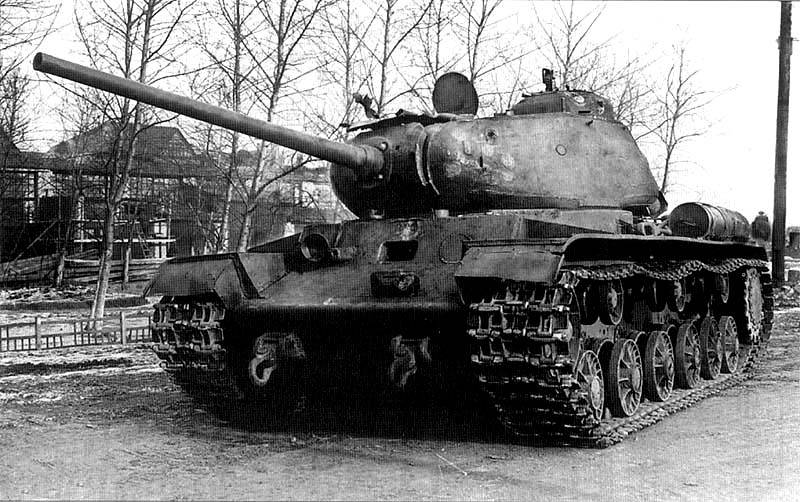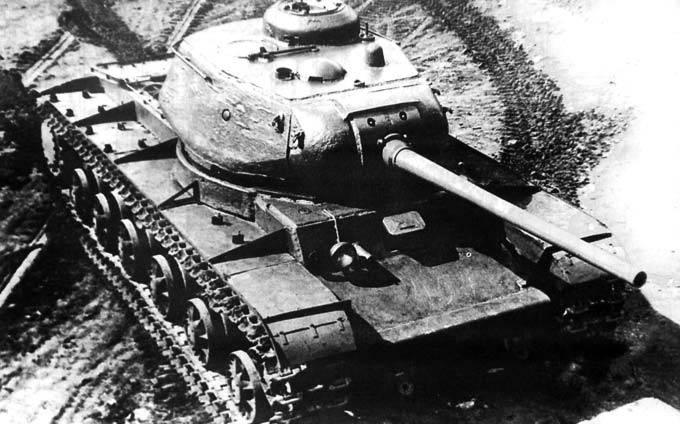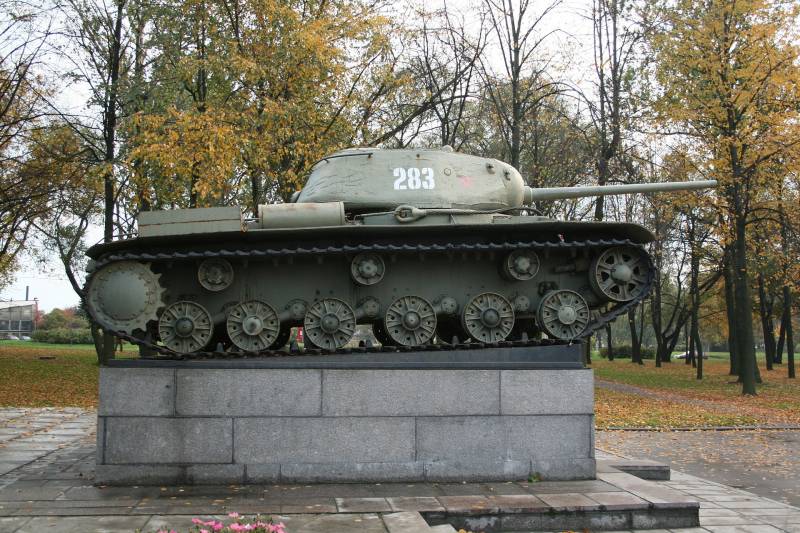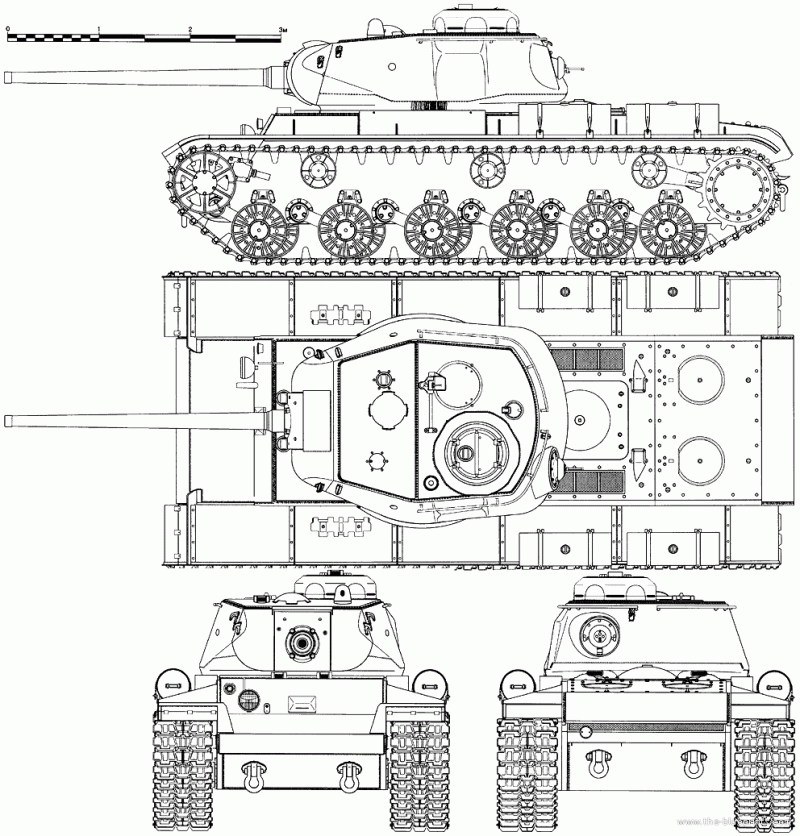Five little-known tanks of the Second World War. Part of 1. Heavy tank KV-85
Let's start our series of articles about little-known tanks of that period with the Soviet heavy tank KV-85, which was released in 1943 in a small series of 148 combat vehicles. We can say that this tank was created in a hurry, as a response to the emergence of new heavy tanks "Tiger" in Germany. Despite the relatively small series, the KV-85 tanks were actively used in combat operations in 1943-1944, up to the complete withdrawal from the Red Army units. All tanks sent to the front were irretrievably lost in battle or written off due to fatal breakdowns and malfunctions. Only one completely authentic KV-85 has survived to this day.
The name of the KV-85 tank is quite informative, we have a version of the heavy Soviet tank "Klim Voroshilov" with a new main armament - an 85-mm tank gun. This heavy tank was created by specialists from the Design Bureau of Experimental Plant No. 100 in May-July 1943. Already on August 8, 1943, the new combat vehicle was adopted by the Red Army, after which the tank was put into mass production at ChKZ - the Chelyabinsk Kirov Plant. The production of this model was carried out in Chelyabinsk until October 1943, when it was replaced on the assembly line by a more advanced heavy tank IS-1, which, by the way, was produced in an even smaller series - only 107 tanks.
The KV-85 was a response to the appearance on the battlefield of the new German tanks "Tiger" and "Panther". By the summer of 1943, the KV-1 and KV-1s were already obsolete, primarily due to their weak armament, the 76-mm tank gun could no longer cope with the new German tanks. She did not pierce the "Tiger" in the forehead, it was possible to confidently hit a German heavy tank only in the sides of the hull or stern and from very short distances - 200 meters, while the "Tiger" could easily shoot KV tanks at all distances of the tank battle of those years . At the same time, one should not assume that the idea to equip Soviet tanks with more powerful guns appeared only in 1943. Even before the start of the war in 1939, the first attempts were made to arm tanks with more powerful guns of 85-95 mm caliber, however, with the outbreak of war, such work was temporarily stopped, and the guns themselves at that time seemed excessively powerful. The fact that the cost of 85-mm guns and shells for them was higher than that of standard 76-mm ones also played a role.
However, by 1943, the issue of re-equipping Soviet armored vehicles was finally overdue, requiring urgent decisions from the designers. The fact that the army's need for new tanks was huge is evidenced by the fact that the KV-85 was adopted by the Red Army on August 8, 1943, even before the end of the full cycle of its tests. Then in August, the tank was put into mass production. The prototype of the tank was built at Pilot Plant No. 100 using the chassis of the KV-1s tank and the turret from the unfinished IS-85, the rest of the tanks were produced by ChKZ. When assembling the first combat vehicles, the accumulated backlog of armored hulls for the KV-1s tank was used, so cutouts were made in the turret box for the extended turret shoulder strap, and the holes for the ball mount of the course machine gun had to be welded. For tanks of subsequent series, all the necessary changes were made to the design of the armored hull.
At the same time, the KV-85 heavy tank was initially considered as a transitional model between the KV-1s tank and the new IS-1 tank. From the first, he borrowed in full the undercarriage and most of the parts of the armored hull, from the second - the turret with the new gun. The changes concerned only the armored parts of the turret box - in the KV-85 tank they were made anew to accommodate a new and larger turret with shoulder straps - 1 mm compared to the heavy KV-1800s tank. The KV-85 had a classic layout, which was typical for all serial Soviet medium and heavy tanks of those years. The hull of the tank was sequentially divided from bow to stern into the control compartment, fighting compartment and engine-transmission compartment (MTO). The tank driver was located in the control compartment, and the other three crew members in the fighting compartment, which combined the turret and the middle part of the armored hull. Here, in the fighting compartment, there was ammunition and a gun, as well as part of the fuel tanks. The transmission and engine - the famous diesel V-2K - were located in the stern of the tank in the MTO.
Being a transitional tank, the KV-85 combines both the advantages of a new, more spacious turret with an 85-mm cannon of the IS-1 tank, and the disadvantages of the undercarriage of the KV-1s tank. In addition, from the last KV-85, it also inherited insufficient hull armor for the second half of 1943 (the largest armor in the forehead - 75 mm, sides - 60 mm), which made it possible to provide acceptable protection only from the fire of German guns caliber up to 75 mm. At the same time, the Pak 40, the most common German anti-tank gun by that time, was quite sufficient to successfully fight the new Soviet tank, although with increasing distance and at certain heading angles, the KV-85 armor was enough to protect against its shells. At the same time, the long-barreled 75-mm Panther gun or any 88-mm gun easily pierced the armor of the KV-85 hull at any distance and at any point. But the turret borrowed from the IS-1 tank, compared to the standard KV-1s turret, provided more reliable protection against artillery shells (gun mantlet - 100 mm, turret sides - 100 mm), also increasing the convenience of the tank crew.
The main advantage of the new KV-85, which distinguished it among all Soviet tanks of that time, was the new 85-mm D-5T gun (before the launch of the IS-1 tank in November 1943). Previously tested on SU-85 self-propelled artillery mounts, the D-5T tank gun was a really effective means of fighting even new German tanks, ensuring their destruction at a distance of up to 1000 meters. For comparison, the 76-mm ZIS-5 cannon, which was installed on the KV-1s tanks, was almost completely useless against the frontal armor of the heavy Tiger tank and hardly hit it on board at distances further than 300 meters. Moreover, increasing the caliber of the gun to 85 mm had a positive effect on the power of high-explosive fragmentation ammunition. This was especially important, since the KV-85 tanks in the Red Army were used as heavy breakthrough tanks. On the other hand, the practice of combat use showed the need for a further increase in the caliber of heavy tanks in order to confidently defeat powerful enemy bunkers and bunkers.
The installation of a new, more powerful gun on the tank required a change in the ammunition rack, the tank's ammunition load was reduced to 70 shells. At the same time, instead of a frontal machine gun located in a ball mount to the right of the mechanical driver, a fixed course machine gun was installed on the KV-85 tanks. The mechanical driver himself conducted indirect fire from this machine gun, which made it possible to reduce the tank crew to four people, excluding the gunner-radio operator from the crew. At the same time, the radio moved to a place next to the tank commander.

The KV-85 became the first Soviet serial tank that could fight the new German armored vehicles at distances up to one kilometer inclusive. This fact was appreciated by both the Soviet leaders and the tankers themselves. Despite the fact that the muzzle energy of the 85-mm D-5T gun of 300 t•m was superior to that of the Panther KwK 42 gun (205 t•m) and was not so much inferior to the gun of the Tiger tank KwK 36 (368 t •m), the manufacturing quality of Soviet armor-piercing ammunition was lower than that of German shells, therefore, in terms of armor penetration, the D-5T was inferior to both of the above guns. The conclusions of the Soviet command from the combat use of the new 85-mm tank gun were mixed: the effectiveness of the D-5T gun was not in doubt, but along with this, its insufficiency was noted for arming heavy tanks, which were supposed to surpass similar enemy combat vehicles in this indicator. As a result, it was later decided to arm T-85 medium tanks with an 34-mm cannon, and new heavy tanks were to receive more powerful 100-mm or 122-mm guns.
Despite the fact that the KV-85 hull still allowed the placement of more powerful artillery systems, its modernization potential was fully exhausted. The designers of plant No. 100 and ChKZ understood this even in relation to the KV-1s tank. This mainly concerned the impossibility of strengthening the armor of the tank and improving its engine-transmission group. For this reason, in light of the planned early launch of new tanks of the IS family, the heavy tank KV-85 was considered from the very beginning as a temporary solution to problems. Although the production process of the KV-1s tank (and then the KV-85) was well-established at Soviet enterprises, the front needed new tanks with more powerful armor and weapons.
Organizationally, the KV-85 tanks entered service with the OGvTTP - separate guards heavy tank regiments. Tanks went to the front literally from the factory; they began to arrive in units as early as September 1943. Each such regiment had 21 heavy tanks in its composition - 4 companies of 5 combat vehicles each, plus one tank of the regiment commander. In addition to tanks, each regiment had in its composition several unarmored support and support vehicles - trucks, jeeps and motorcycles, the regular strength of the regiment - 214 people. The lack of heavy self-propelled guns SU-152 in the front-line units led to the fact that in some cases the KV-85 tanks could be regularly introduced into separate heavy self-propelled artillery regiments (OTSAP), where they replaced the missing self-propelled guns.

Around the same time, in late 1943 - early 1944 (with some delay necessary to form new units and send them to the front), heavy tanks KV-85 entered the battle with the enemy, they were mainly used in the southern directions of the front. Somewhat inferior in their characteristics and capabilities to the new German heavy tanks, the battles involving the KV-85 went on with varying success, and the result of the confrontation with the enemy was largely determined by the training of tank crews. At the same time, the main purpose of the KV-85 at the front was not tank duels, but a breakthrough in advance prepared enemy defense lines, where the main danger was not the enemy’s armored vehicles, but his anti-tank weapons, engineering and mine-explosive barriers. Despite insufficient armor for the end of 1943, the KV-85 tanks performed their task, albeit at the cost of tangible losses. Intensive use at the front and a small volume of serial production led to the fact that by the autumn of 1944 there were no KV-85 tanks left in combat units. This was caused by deadweight losses and the write-off of faulty machines. No mention of the combat use of the KV-85 tanks later than the autumn of 1944 has survived to this day.
Performance characteristics of the HF-85:
Overall dimensions: body length - 6900 mm, width - 3250 mm, height - 2830 mm.
Combat weight - 46 t.
The power plant is a diesel 12-cylinder B-2K engine with horsepower 600.
The maximum speed is 42 km / h (on the highway), 10-15 km / h over rough terrain.
Power reserve - 330 km (on the highway), 180 km (over rough terrain).
Armament - X-NUMX-mm cannon D-85T and 5x3-mm machine gun DT-7,62.
Ammunition - 70 shells.
Crew - 4 person.
Information sources:
http://www.aviarmor.net/tww2/tanks/ussr/kv85.htm
http://tanki-v-boju.ru/tank-kv-85
http://pro-tank.ru/bronetehnika-sssr/tyagelie-tanki/117-kv-85
Open source materials


Information